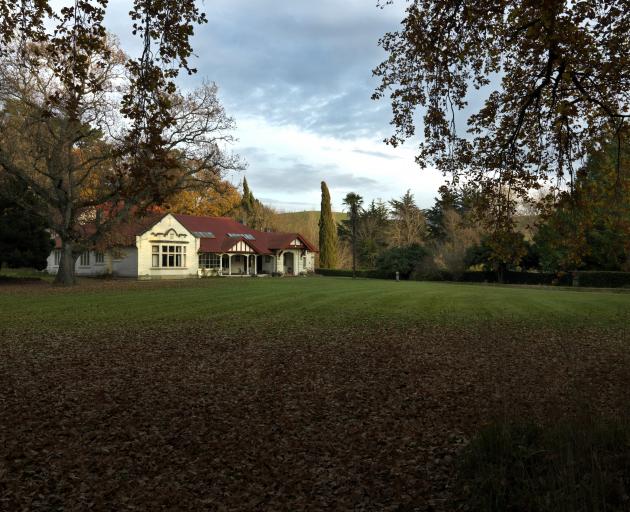
Often inspired by the stately English homes their owners left behind, the local equivalents responded to their colonial context, as well as to the variety of functions they served at the centre of a working farm.
In this extract from Homesteads: The story of New Zealand’s grand country houses, author Debra Millar and photographer Jane Ussher look at Kuriheka Estate in North Otago.
The homestead at Kuriheka Estate in North Otago has remained virtually unchanged from when it was first occupied, despite the fact it has long been separated from the 31,000 acre (12,500ha) farm that surrounded it.

Rooms are furnished just as they were when Joseph Nichols died in 1954, with important antiquities, curios, paintings and a library of books that date back to 1471. Family letters and journals have been kept, alongside diaries and accounts of Joseph’s military career, first as commander of the Otago Mounted Rifles and then as commander of the Otago Military District during World War 1. Farm records provide a detailed history of the once thriving station’s past.
Until 2006, the homestead also housed an important collection of more than 600 military medals, including a full set of British campaign medals dating back to the Battle of Waterloo. They were reluctantly sold at auction in London to raise funds to assist with the homestead’s upkeep.

Joseph Nichols established the Kuriheka Settlement Trust in 1936 with the intention of preserving the homestead and the associated farm buildings along with 186ha of land. The trust deed and its provisions have unfortunately created a vexed situation for Tim, who is motivated to preserve the house and its contents, but limited in terms of his influence.

Charles died in 1878 when a horse-drawn coach he was travelling in crashed north of Dunedin. His wife Mary was paid out by Dalgety in mortgage certificates held over South Island farms. She headed to Europe the following year with Joseph, aged 19, and his eight siblings, so the children could be educated.
Joseph attended Cambridge University before returning to New Zealand, then continued on to Australia for a grounding in farming. Five years after he bought Kuriheka he married Helen Ayre (known as Nell), whose family station he had worked on in New South Wales. Mary had the Kuriheka homestead’s drawing room erected as a wedding gift for the couple, along with the two-storey stables, which were built to a design she bought in Germany. The stables have a Heritage New Zealand category 1 classification and with their unusual Gothic-inspired arched windows, have a definite European air.
A timber house dating from 1864 already existed when Joseph bought the station. The Oamaru stone homestead that stands today was completed in two stages, in 1905 and 1927, with each stage marked by a foundation stone. The architect for both sections of the house was John Forrester, whose father founded the firm, Forrester and Lemon, which designed many of Oamaru’s best-known limestone buildings.

Across the entrance hall is the house’s crowning glory: the Scottish-style baronial hall, also added in 1927. It is a massive room with a soaring 4.6m-high ceiling and a grand Oamaru stone fireplace carved with ancestral coats of arms.
The now-loose rewarewa parquet floor is scattered with Belgian rugs, and the walls are adorned with family portraits, including paintings of Mary Nichols and her sister Emily by the portrait artist, James Jebusa Shannon, which are said to have once hung in the Tate Gallery in London. Alongside antique military helmets and a display of weapons from Europe, Asia and Africa is a suit of French tournament armour reputedly made for a young Louis XIV.

In the entrance hall, Dutch stained-glass windows dated from 1730 frame the heavy timber front door. A display of Aboriginal Australian boomerangs and tools from Tasmania is an unexpected discovery affixed to the room’s rimu ceiling.
The study, which was added as part of the 1927 additions, is set up just as it would have been found in Joseph Nichols’ day, with books and farm records kept in Edwardian-style glass-fronted bookcases. A reading table in the centre of the room was built from an oak tree felled on the farm.
Although the 2000sq m, 32-room homestead is largely unoccupied these days, with Tim now the only inhabitant of the two-storey servants’ wing at the rear of the house, it is far from neglected. Tim is a passionate custodian and enthusiastic protector of his family’s past, and happily continues to share the stories of this remarkable home.
GIVEAWAY
The Otago Daily Times has a copy of Homesteads: The Story of New Zealand’s Great Country Houses, written by Debra Millar with photos by Jane Ussher, to give away. To enter the draw, email playtime@odt.co.nz by Friday, October 23, with your name, address and day-time phone number in the body of the email and "Homesteads" in the subject line.











